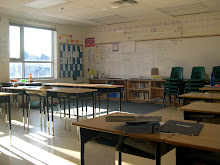After one and a half weeks of thorough observation of this group of boys' reading behavior, habits and ability during morning work, read aloud, or reader's workshop, I have decided to finalize my two focal students: Jesse and Nathan.
The reasons behind this decision is that (1) Jon is an ELL student; his presence is not relevant to my research question, and (2) I believe that in order to get the boys to be concentrated in reading, there has to be less distractions for them. Having seen them in a big group last week suggests me that these boys need to be divided up and work in partnership so that each of them can focus better during book club or guided reading.
After interviewing Jesse and Nathan, I have learned a lot more about them; my knowledge of these boys are not only limited to their identity as readers, but more holistically as individual learners. Jesse expresses to me that he indeed likes to read, but he is very selective in his readings (see exhibit 6). From this interview, I have come up with some implications: (1) once he is engaged in a book, he likes to reread it as many times. This is why he can be resistant to reading new, unfamiliar books; (2) he likes to read aloud to his mother only. She is perhaps his role model in reading, and he feels comfortable reading to her; and (3) he gets annoyed when he is interrupted during reading, which is probably why he is not enjoying guided reading/ book club or conferring. I think what I need to do next with Jesse is to find some ways to introduce other genres during read aloud, and continue to encourage him to read to his teachers, as well as his siblings at home.
As for Nathan (see exhibit 7), he reacts quite differently in comparison. He also enjoys reading, but he has this negative belief that he thinks he is not a good reader. Although Nathan's behavior does not seem to be failure-avoidant, it is still worthwhile to keep this information on the account just in case this behavior does appear more frequently or more seriously in the future. Another issue that bothers Nathan as a reader is that he is simply turned-off by thick books that have a lot of text. He also expresses his dislikes with Cam Jensen (a mystery series), particularly because of the portrayal of the main character Cam, who seems to know every clue and solution of a mystery. In light of this, I wonder if Nathan's resistance in reading this particular series is due to a female main character who is portrayed as a young girl who is powerful in solving every mystery that she encounters. Bomer and Bomer (2001), describe the different lenses for reading. I am interested in knowing if Nathan is indeed using the "gender lens" to evaluate and critique texts that he reads. I am thinking of introducing different genres with characters whose behavior and action reflect the social norm, and those whose don't. This investigation can help me to find out what genre or type(s)of character can arouse his interest in reading.
For independent and guided reading, I am not sure what I can do at this moment to get him interested in conferring and discussing books with others. Getting him to sit still during reading is indeed a challenge. My next step is definitely to promote the importance of building stamina in reading through various strategy lessons that encourage and positively reinforce the expectations during reading workshop.












